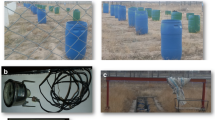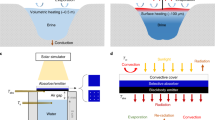Abstract
Evaporation from the water surface is one of the important topics in management and decision making for water resources. For this reason, measuring the evaporation rate is highlighted. In this study, the evaporation equation is determined with appropriate accuracy by constructing a laboratory device at first. Then, the evaporation rate of the water surfaces covered with photovoltaic panels is calculated and presented in the form of a new experimental equation. The proposed experimental equation is examined and analyzed in different modes and is validated by laboratory data. According to the results, the predicted value by this equation has an average error of about 10.53%, which is acceptable compared to other equations. According to the results, the application of photovoltaic panels on the lake dam surface by 25, 50, 75, and 100% reduces water evaporation by 16.36, 23.28, 43.28, and 69%, respectively. This indicates less evaporation in the surface covered by the panel.
Graphical abstract









Similar content being viewed by others
References
Al-Ghobari HM (2000) Estimating of reference evapotranspiration for southern region of Saudi Arabia. Irrig Sci 19:81–86
Al-Shalan SA, Salih AMA (1987) Evapotranspiration estimation in extremely arid areas. J Irrig Drain Eng 1987:565–574
Asmani M, Bashirnezhad K, BashiShahabi P (2020) Determining the empirical equation for estimating the evaporation from open water surfaces. Int J Future Gener Commun Netw 13(4):1091–1103
Assouline S, Narkis K, Or D (2010) Evaporation from partially covered water surfaces. Water Resour Res 46(10):W10539
Bei Y, Yuan B, Wang Z, Tang J (2022) Floating Photovoltaic for the Coal Mining Subsidence Water Area—an Effective Way to Reduce Evaporation. 2022 5th International Conference on Energy. Electrical and Power Engineering (CEEPE), IEEE, pp 1126–1130
Bontempo F, Marco Tina G, Gagliano A, Nižetić S (2020) An assessment study of evaporation rate models on a water basin with floating photovoltaic plants. Int J Energy Res. https://doi.org/10.1002/er.5170
Bontempo Scavo F, Tina GM, Gagliano A, Nižetić S (2021) An assessment study of evaporation rate models on a water basin with floating photovoltaic plants. Int J Energy Res 45:167–188
Clayton LH (1989) Prediction of class a pan evaporation in south Idaho. J Irrig Drain Eng 115(2):166–171
Fan K, Cai M, Wang F et al (2019) A string-suspended and driven rotor for efficient ultra-low frequency mechanical energy harvesting. Energy Conver Manage 198:111820. https://doi.org/10.1016/j.enconman.2019.111820
Farrar LW, Bahaj AS, James P, Anwar A, Amdar N (2022) Floating solar PV to reduce water evaporation in water stressed regions and powering water pumping: case study Jordan. Energy Convers Manage 260:115598
Hamon WR (1963) Computation of direct runoff amounts from storm rainfall. Int Assoc Sci Hydrol Publ 63:52–62
Jabulani J (2008) Evaluation of the potential of using the modified Jensen-Haise model asan irrigation scheduling techniquein Zimbabwe Electronic. J Environ Agri Food Chem 7(14):2771–2778
Jensen ME, Haise HR (1963) Estimating evapotranspiration from solar radiation. Proceedings of the American society of civil engineers. J Irrig Drain Division 89:15–41
Liu H, Kumar A, Reindl T (2020) The Dawn of Floating Solar—Technology, Benefits, and Challenges. WCFS2019. Springer, pp 373–383
Lopes MPC, Nogueira T, Santos AJL, Branco DC, Pouran H (2022) Technical potential of floating photovoltaic systems on artificial water bodies in Brazil. Renewable Energy 181:1023–1033
Penman HL (1948) Natural evaporation from open water, bare soil and grass. Proceedings of the royal society of London series A. Math Phys Sci 193(1032):120–145
Penman HL (1963) Vegetation and hydrology. Soil Sci 96(5):357
Ren Y, Wei S, Cheng K, Fu Q (2018) Valuation and pricing of agricultural irrigation water based on macro and micro scales. Water 10(8):1044
Rosa-Clot M, Tina GM, Nizetic S (2017) Floating photovoltaic plants and wastewater basins: an Australian project. Energy Procedia 134:664–674
Rosenberry DO, Stannard DI, Thomas CW, Martinez ML (2004) Comparison of 13 equations for determining evapotranspiration from a prairie wetland, Cottonwood lake area, north Dakota, USA. Wetland Sci 24(3):483–497
Shadmani M, Maroofi S (2011) Comparison of several methods for estimating daily evaporation from the pan––a case study of Kerman region. J Agri Sci Technol Nat Resou soil Water Sci 15:69–83
Sharma P, Muni B, Sen D (2015) Design parameters of 10 KW floating solar power plant. In: Proceedings of the International Advanced Research Journal in Science, Engineering and Technology (IARJSET), National Conference on Renewable Energy and Environment (NCREE-2015), Ghaziabad, India.
Soltani SRK, Mostafaeipour A, Almutairi K, Dehshiri SJH, Dehshiri SSH, Techato K (2022) Predicting effect of floating photovoltaic power plant on water loss through surface evaporation for wastewater pond using artificial intelligence: a case study. Sustain Energy Technol Assess 50:101849
Stephens JC (1963) A comparison of procedures for computing evaporation and evapotranspiration. publication 62, international association of scientific hydrology. Int Union Geodyn 1963:123–133
Taboada M, Cáceres L, Graber TA et al (2017) Solar water heating system and photovoltaic floating cover to reduce evaporation: experimental results and modeling. Renewable Energy 105:601–615. https://doi.org/10.1016/j.renene.2016.12.094
Trajkovic S, Kolakovic S (2009) Evaluation of reference evapotranspiration equations under humid conditions. Water Resour Manage 23(14):3057–3067
Vazifedoost M, Alizadeh A, Farid A, Majidi M (2015) Estimating evaporation from lakes and reservoirs under limited data condition in a semi-arid region. Water Resour Manage 29:3711–3733
Yao H, Creed IF (2005) Determining spatially-distributed annual water balances for ungauged locations on. Hydrol Sci J 50:245–263
Youssef YW, Khodzinskaya A (2019) A review of evaporation reduction methods from water surfaces. In: E3S Web of Conferences, EDP Sciences.
Zamiri A, Parvishi A (2017) Calculation of evapotranspiration of crops and horticultural crops by Five-Penman-Montith method using Cropwat software and its comparison with Netwat software (Case study of Miandoab city). In: Third annual conference of architectural, urban planning and urban management research 2017, undefined.
Acknowledgements
Maziar Asmani expresses his thankfulness to the great professor, Mohammad Saleh Pordel for encouraging him. Also, he would like to appreciate the Energy Laboratory of the Islamic Azad University, Mashhad Branch, for assisting in establishing and operating the laboratory device.
Funding
This research did not receive any specific grant from funding agencies in the public, commercial, or not-for-profit sectors.
Author information
Authors and Affiliations
Corresponding author
Ethics declarations
Conflict of interest
The authors declare that they have no conflict of interest.
Additional information
Editorial responsibility: Maryam Shabani.
Supplementary Information
Below is the link to the electronic supplementary material.
Rights and permissions
Springer Nature or its licensor (e.g. a society or other partner) holds exclusive rights to this article under a publishing agreement with the author(s) or other rightsholder(s); author self-archiving of the accepted manuscript version of this article is solely governed by the terms of such publishing agreement and applicable law.
About this article
Cite this article
Asmani, M., Bashirnezhad, K., Shahabi, P.B. et al. Determining an equation for estimating the evaporation from water surfaces covered with photovoltaic panels. Int. J. Environ. Sci. Technol. 20, 10661–10672 (2023). https://doi.org/10.1007/s13762-023-04910-z
Received:
Revised:
Accepted:
Published:
Issue Date:
DOI: https://doi.org/10.1007/s13762-023-04910-z




